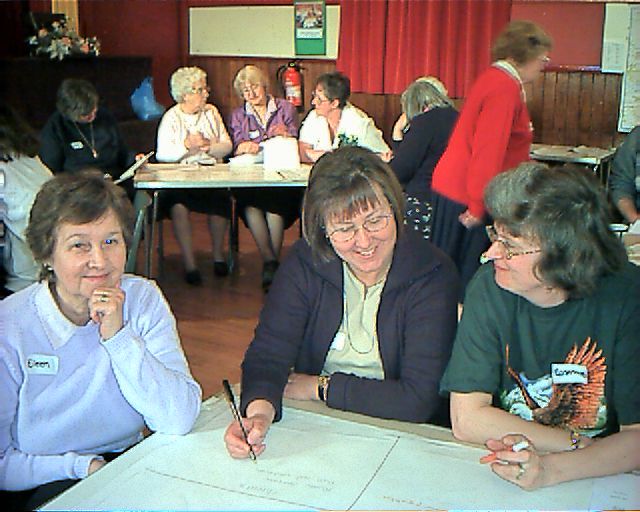Last time I wrote about how “Motivation and Meaning” is behind all economic and political systems. In this third part of my review of “Change Everything” by Christian Felber, I shall consider his chapter about “Advancing Democracy”, wherein Felber suggests a three pillar democracy.
Sovereignty
The chapter describes an approach to democracy where the people are sovereign. Felber lives in Austria and many of the examples are from Central Europe. Quite how this idea goes down in the UK, with a monarch as sovereign, is not yet known. (Political parties opposed to membership of the EU, claim they believe in national sovereignty for the UK by which they presumably mean sovereignty of the monarch. In the real world, Parliament has handed over sovereignty to the large corporations and I don’t suppose leaving the EU will make much difference to that. This doesn’t make me optimistic that we’ll see a sensible or informed debate about sovereignty in this country.)
The September 2014 Scottish referendum is an example of how direct democracy can empower populations. Felber claims the sovereign people are usually more cautious than their politicians. The results of the referendum, show a significant majority voted to stay as part of the UK. However, the referendum radicalised the people and so in the General Election, May 2015, most seats went to the Scottish National Party (SNP).
The problem was with the referendum itself. The politicians designed the question to meet their own interests. The ambiguities meant many who voted no in the referendum actually wanted change as we saw in the General Election results. If the results of the first ballot was a no to the SNP, the results of the second was a no to the Westminster élite. Is anyone planning to find out what the people actually want?
A Constitutional Convention
Felber would suggest establishing a convention, independent of the Scottish or UK parliaments. The people would elect members of the convention whose task would be to come up with a political solution acceptable to the people of Scotland. A referendum confirms their recommendations.
Under such a system, referendums would stop being the plaything of governments and become a genuine element of participative democracy. I am not optimistic referendums can offer the public a free choice whilst politicians set the question.
Three-Pillar Democracy
Felber suggests a three pillar approach to democracy that mirrors my three function model for community development.
Representative Democracy
So, representative democracy at national level mirrors the representational role of community organisations. (This link is to the first of three.) However, practical considerations limit the direct democratic involvement of people. This is why we elect parliaments, councils, etc – we entrust politicians to act on our behalf. That our politicians are not accountable between elections is one the major democratic challenges we face. They write the manifestos and then can change them once they’re in power. We get to vote for parties and can’t pick and mix policies between parties. If we disagree with a decision made during a term of office, we have no way of communicating which policy we disagree with through voting.
Our politicians cannot be trusted to truly represent people’s views. They decide the agenda and have exclusive powers to draft legislation, treaties, etc. Their most powerful lobbies are the corporations. The politicians have given away too much power to these lobbies and ordinary citizens have nothing like equal power over the politicians they elect.
Direct Democracy
This is where the second pillar comes in, direct democracy. This mirrors the planning stage of my three function model. Locally, planning is an opportunity for community organisations to meet with other local interest groups such as the council, police, NHS and local businesses.
A convention would be equivalent to representatives of community organisation directly involved in negotiations. The elected convention’s task is to draft treaties and other agreements, which act as frameworks for politicians, on behalf of the people. They would not normally draft legislation, their role is constitutional. So, determination of the relationship between Scotland and the rest of the United Kingdom, would include the roles of the Scottish and Westminster parliaments. Parliaments make decisions about legislation within the constitutional agreement. The convention would act in an open way, consulting with all interests and producing legislation for agreement at a referendum.
This would be for deciding constitutional issues, eg Scotland’s governance, the treaty with Europe (an international convention, perhaps?) and so on. Anything requiring a referendum would start with a convention. The referendum would be to accept or reject the findings of the convention.
Participatory Democracy
Finally, participatory democracy is equivalent to the delivery function in my local model. It is where people can be directly involved in their place of work, for example.
As these three pillars develop, they reinforce one another. As people find out about the enhanced power of participatory democracy, they are likely to increase their own involvement. With such political structures in place, we are likely to find they reinforce democratic involvement in our neighbourhoods and work places as well as at council and parliamentary levels. We will rediscover the political process in the marketplace.
The three local functions may seem weaker than the national democratic functions. This is a product of contemporary national politics; national politics is more powerful and the weakness of local politics is part of the same system. Introducing these three distinct pillars of democracy would strengthen local democracy people became more familiar with democratic participation.

![By Australian Institute of Aboriginal and Torres Strait Islander Studies [CC BY-SA 4.0 (http://creativecommons.org/licenses/by-sa/4.0)], via Wikimedia Commons Audience in rows with keynote speakers](https://communitywebconsultant.com/wp-content/uploads/2015/08/Keynote_speaker_Professor_Taiaiake_Alfred_addresses_the_audience_during_a_symposium_on_cultural_strength_Stanner_Room_AIATSIS_11th_February_2015.jpg)


